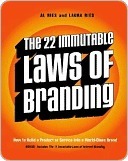More on this book
Kindle Notes & Highlights
by
Al Ries
Successful branding programs are based on the concept of singularity. The objective is to create in the mind of the prospect the perception that there is no other product on the market quite like your product.
The power of a brand is inversely proportional to its scope.
Today brands are born, not made. A new brand must be capable of generating favorable publicity in the media or it won’t have a chance in the marketplace. And just how do you generate publicity? The best way to generate publicity is by being first. In other words, by being the first brand in a new category.
What others say about your brand is much more powerful than what you say about it yourself. That’s why publicity in general is more effective than advertising.
Leaders should not look on their advertising budgets as investments that will pay dividends. Instead leaders should look on their advertising budgets as insurance that will protect them against losses caused by competitive attacks.
Ask not what percentage of an existing market your brand can achieve, ask how large a market your brand can create by narrowing its focus and owning a word in the mind.
When you don’t have the leading brand, your best strategy is to create a new category in which you can claim leadership.
” Never forget leadership. No matter how small the market, don’t get duped into simply selling the benefits of the category early in the branding process.
A widely publicized study of twenty-five leading brands in twenty-five different product categories in the year 1923 showed that twenty of the same twenty-five brands are still the leaders in their categories today.
If you want to build a powerful brand, you have to build a powerful perception of quality in the mind.
the law of contraction. What happens when you narrow your focus? You become a specialist rather than a generalist. And a specialist is generally perceived to know more, in other words to have “higher quality,” than a generalist.
Another factor in building a high-quality perception is having a high price. Rolex, Häagen-Dazs, Mercedes-Benz, Rolls-Royce, Montblanc, Dom Pérignon, Chivas Regal, Absolut, Jack Daniel’s, and Ritz-Carlton are all brands that benefit from their high price. High price is a benefit to customers. It allows the affluent customer to obtain psychic satisfaction from the public purchase and consumption of a high-end brand.
The most efficient, most productive, most useful aspect of branding is creating a new category. In other words, narrowing the focus to nothing and starting something totally new.
You have to launch the brand in such a way as to create the perception that that brand was the first, the leader, the pioneer, or the original. Invariably, you should use one of these words to describe your brand. You have to promote the new category.
. Customers don’t really care about new brands, they care about new categories.
the rise of competitive brands can stimulate consumer interest in the category.
) Brands are not just something to think about at marketing meetings. Brands are the essence of the company itself. A company’s very existence depends on building brands in the mind. And so does a country’s.
If the market is moving out from under you, stay where you are and launch a second brand. If it’s not, stay where you are and continue building your brand.
The brand itself should be the focus of your attention. If you have to use the company name, use it. But do so in a decidedly secondary way.
The strength of a brand lies in having a separate, unique identity—not in being associated in the mind with a totally different category. Having a totally separate identity in the mind doesn’t mean creating a totally separate organization to handle each brand.
A logotype is a combination of a trademark, which is a visual symbol of the brand, and the name of the brand set in distinctive type.
Of equal importance to shape is legibility. Logotype designers often go way overboard in picking a typeface to express the attribute of a brand rather than its ability to be clearly read.
Every country has its own unique perceptions. When a brand is in sync with its own country’s perceptions, that brand has the possibility of becoming a global brand.
The difference between the Internet and every other medium is interactivity.
(If you were a language purist or work for the U.S. Trademark Department, you would call brand names “proper adjectives,” as in “Mercedes-Benz cars.” But most people use brand names as nouns. They will say, “I drive a Mercedes,” not “I drive a Mercedes car.”)
So which brand will be the winner in each category? It won’t necessarily be the brand that was first in the marketplace. It won’t necessarily be the brand that was first to become profitable. The winner will be the first brand to establish a dominant position in the prospect’s mind.
Death and taxes used to be the only certainties in life. Today you can add one more: advertising. Advertising messages are ubiquitous. Everywhere you turn you’ll find an advertising message.
) When the name on the stadium is worth more than the physical stadium itself, you know that we live in an advertising-oriented world.


